Husqvarna’s flagship motocrosser is mellow, but it’s not yellow.
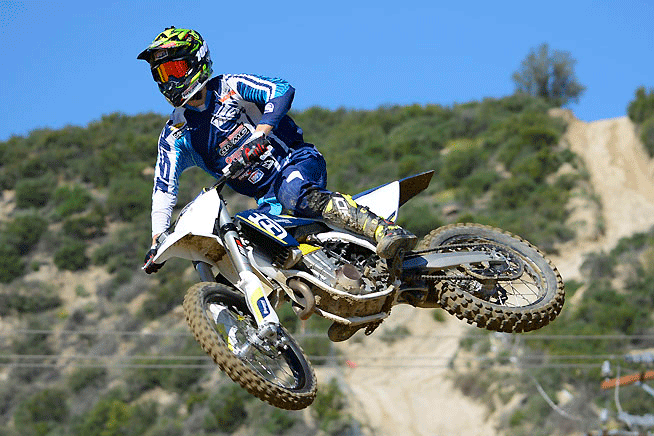
We can understand why Husqvarna officials get annoyed with folks who insist that the new Huskies are merely KTMs that have been rebadged and covered in white bodywork, because that simply isn’t true.
Granted, other than the hallowed brand name, nothing remains of the Swedish Huskies that many hard-core off-road fans knew and loved, but the reality is that that hasn’t been the case for a long time. The Husqvarna name has had to survive in the off-road marketplace by adorning Italian Cagiva-built models and German BMW-built models in the past, but it is important to note that the brand has never ceased production. Now, under KTM’s tender loving care, the Husqvarna brand has once again begun to flourish, topping all sales record held by its previous generations. One ride on the 2016 Husqvarna FC450 is all it takes to know why. Husqvarna’s latest 450cc moto-thumper is worthy of recognition as a competitive machine, and it has already gone where no Husky ever went before, to the top of the winner’s rostrum in the premier class of AMA Supercross competition. Twice.
Even from the beginning, the two bikes had subtle differences that are more obvious in the 2016 model. Sure, the two still share basic engineering designs, but time and testing have allowed the Husqvarna to continue to forge its own identity. Whereas the KTM 450 SX-F is a more brutal, hard-hitting machine best suited for top-level pro riders, the Husqvarna FC450’s character is more mellow and user-friendly. But that doesn’t mean it is slow, nor does it take a back seat to its orange sibling.
Husqvarna says that the 2016 FC450 packs the most powerful Husqvarna motocross engine ever to carry the brand’s name. The engine’s claimed 63 crankshaft horsepower comes from an all-new, compact power unit that is 23mm shorter, 23mm narrower and 9mm lower than the previous version. The redesign meant that every internal component had to be revised and repositioned, but the process was worth it as it shaved 3.96 lbs. from the FC450. In some instances, doing away with excess bulk came as a result of more economic functionality, such as by incorporating a counterbalancer shaft that also drives the water pump and timing chain to reduce complexity as well as mass. More power was also freed up via the use of a low-friction DLC on the FC450’s rocker arms to help the Husky make the most of its available revs.
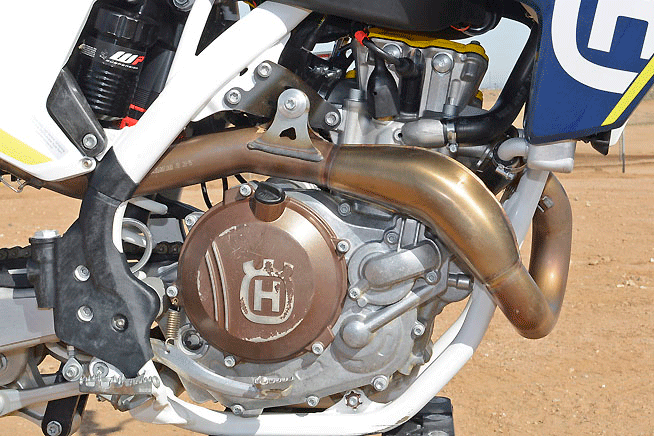
Up top, the FC450’s cylinder head is completely new, with a different combustion chamber, intake and exhaust ports that take advantage of new camshaft profiles A low-friction DLC coating is used on the rocker arm, new shorter timing chain and low-friction chain guides all help the mighty Husqvarna engine to reach its 11,500 rpm redline. The power pulses take place in a 95mm bore cylinder that is positioned 6mm lower and houses a CP bridge-box-type piston. The FC450’s compression ratio is 12.6:1. The bottom end contains a new crankshaft design boasts 10% more inertia and has been repositioned 9mm backwards and 7mm higher in the FC450’s die-cast engine cases.
The FC450 also gets a new Keihin 44mm throttle body that uses no throttle linkage. Instead, the throttle cables are mounted directly to the throttle body to save weight. A new EMS also adds a launch control function and allows the rider to tailor the engine mapping to meet rider preferences and track conditions. The rider can choose among three maps via a small switch on the handlebar. The maps include a standard setting, plus “Aggressive” and “Soft” settings to control the Husqvarna’s output. The engine maps can also be customized by using Husqvarna’s accessory mapping tool.
Robust mid-range power is the HC450’s calling card on the track. Our expert tester, reigning World Off-Road Champion (WORCS) and former Baja 1000 Champion Robby Bell found the new engine to be a little light on low-end grunt even with the most aggressive stock map during our test session at Southern California’s Glen Helen Raceway. In fact, if we’d had one, we would have tried a two-tooth larger rear sprocket to help the FC snap into its mid-range sooner, because once there the bike is a rocket, pulling long and hard before signing off slightly as it heads toward its 11,500 rpm rev ceiling.
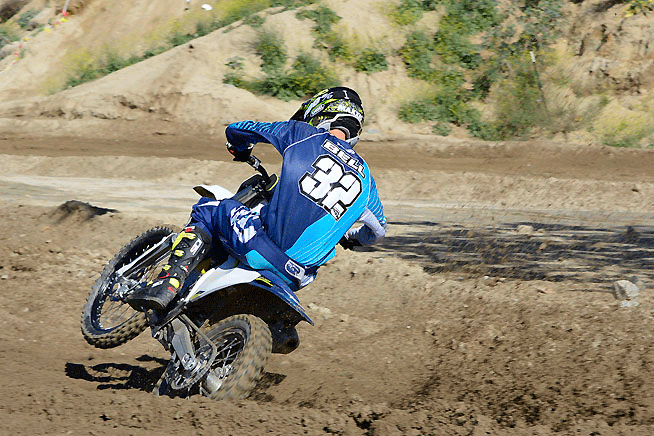
For experts, the fastest lap times are obtained by working the FC450’s Magura hydraulic-actuated DDS (Dampened Diaphragm Steel) clutch and rowing its smooth-shifting five-speed gearbox to keep the motor in its mid-rpm sweet spot rather than relying on overrev to hustle from corner to corner or clear the next jump. The FC450 still exhibits robust top-end power, and it won’t fall on its face if you should need to hang onto a particular gear a little longer, but focus on keeping it in the middle of the power curve and you’ll be able to hang with any other bike in the class.
Fortunately, clutch and shifting performance are very good on the FC450. Husqvarna engineers also reworked the DDS clutch, which uses a single diaphragm steel pressure plate instead of traditional coil springs, by adding a lighter one-piece, CNC-machined steel clutch basket that allows the use of thinner clutch plates to decrease the engine’s rotating mass. The change is noticeable, as the FC450 exhibits a light, crisp, free-revving feel.
The transmission, too, is lighter and more compact, boasting gears that are 8mm narrower and 350 grams lighter than the previous FC450’s parts. A new surface treatment on first and fifth gears is applied to improve reliability and, a new low-friction coating on the shifting fork and redesigned shift drum have been incorporated to facilitate quick and clean gear changes.
The real beauty of the new powertrain will most likely appreciated more by novices, intermediates and vets than by experts, as the Husqvarna’s ultra-smooth and hearty mid-range helps to reduce rider fatigue during long motos. While Husqvarna already has off-road racing customers covered with its FE range of off-road models, we’re confident that the FC450’s user-friendly open-class power could also provide the basis for an excellent off-road and woods machine—and we’re big on versatility.
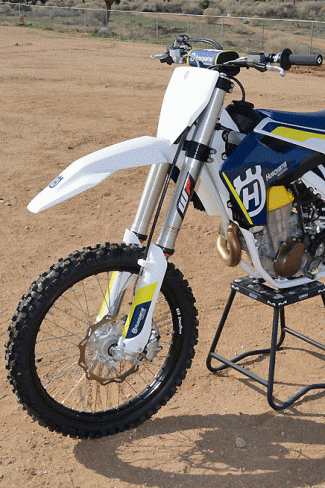
A new, 12mm shorter, 500-gram lighter WP piggyback reservoir shock resides out back, incorporating a new, larger gas chamber, new piston and a new shock shaft. A new clevis design allows the shock to be 12mm shorter while its stroke is actually 3mm longer. The shock is also fully adjustable for high- and low-speed compression damping as well as rebound damping, and its threaded collars allow the rider to adjust spring preload. The shock linkage has also been completely redesigned to match the new rear shock. The pull rod length is 3.2mm longer and a redesigned bell crank has been used to maintain a progressive rate that Husky says is very similar to that of the 2015 FC450.
We had no complaints about the performance of the rear end through Glen Helen’s choppy high-speed bumps, but Bell found the fork to be a tad too soft for a rider of his skill level. Despite upping the compression and rebound damping, the 4CS has a tendency to blow through its travel a little too easily, which can make the front end a tad nervous under high-speed braking. Changing the springs may not be enough for experts, who may also want to opt for a revalve as well. On the plus side, the FC450 floated through chop and handled Bell’s monster sky shots with zero difficulty.
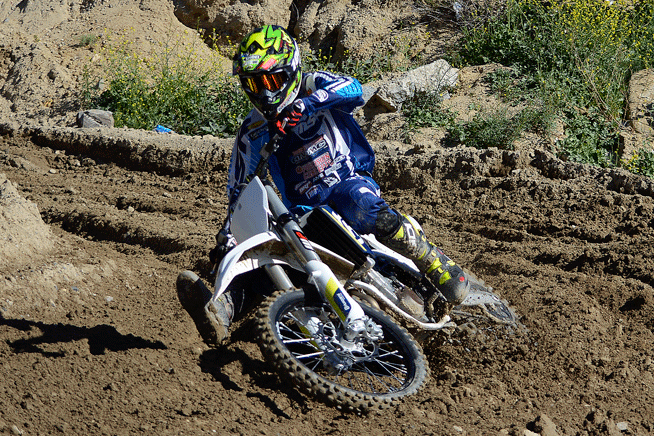
And where it comes to the brakes, the FC450 is equipped with some of the best in the business, Brembo. The two-piston front caliper doesn’t seem to grab the Husky’s GSK 260mm front rotor as aggressively as we are used to, which is not an indictment as Brembos have historically received a bad rap for being too abrupt. We’ll take the FC450’s linear feel over wheel-locking power any day. Stronger stopping performance may only be a pad change away, and the same is true for the single-piston caliper and 200mm GSK rotor out back. Overall, however, the Husqvarna’s braking performance is very good and more likely to suit a wide range of riding styles.
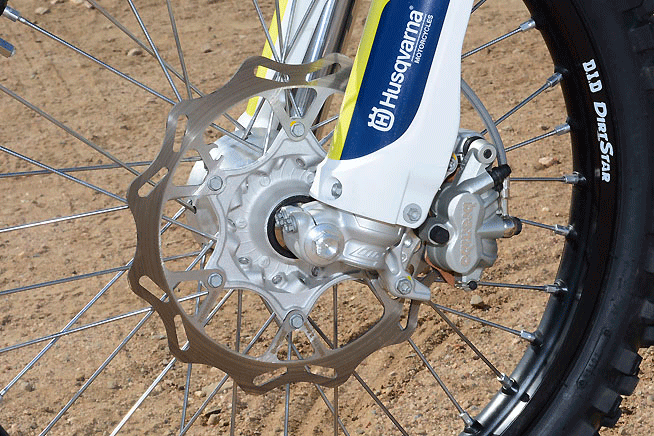
All 2016 Husqvarna’s received an all-new chassis, and we like the results on the FC450. The all-new chrome-moly frame, carbon fiber subframe and new cast aluminum swingarm shave weight from the overall package and are claimed to be more rigid than ever. The hydro-formed, laser-cut and robot-welded frame is .8 lbs. lighter, slightly wider and slightly lower than before, and it is claimed to offer a 20% increase in torsional rigidity and 30% less longitudinal stiffness compared to the previous frame. A new three-piece carbon-fiber subframe is more compact, and it shaves another 2.2 lbs., helping to lower the FC450’s center of gravity. The Husky’s cast aluminum swingarm has also been redesigned. It’s stiffer while also being over half a pound lighter than the previous swingarm.
On the track, these changes are much appreciated. The FC450 imparts a feathery feel, and it can steer with precision in most instances, although, again, it does tend to shake under heavy braking into bumpy corners, and Bell also noted that it was a tad nervous at higher speeds, such as during the run through Glen Helen’s famous, banked Talladega first turn. We blame the soft fork and not the chassis for that, though, because once the shake stops, front-end traction through the middle of the corner and off the corner is just fine. The Husqvarna feels planted and solid.
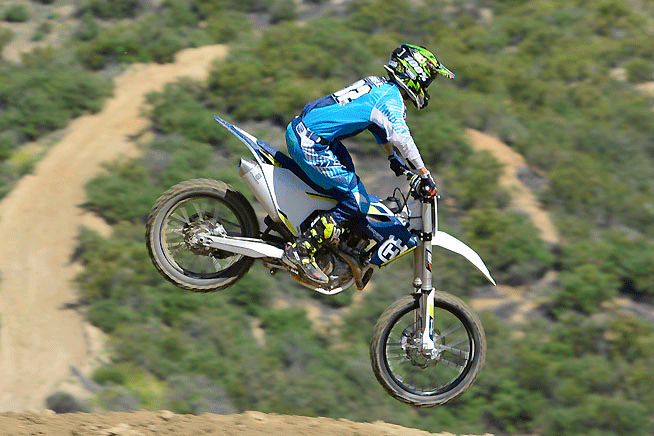
The Husky’s chassis ergonomics are also favorable, although Bell did offer one direct comparison to the KTM by stating that both brands tend to exhibit more of a “sit-on-top” feel whereas Japanese models such as Suzuki’s RM-Z450 and Kawasaki’s KX450F have more of a “sit-in-it” feel. For a 6-footer such as Bell, the FC450’s Pro Taper fat handlebar may also feel a little too low when standing, although remember that the Husqvarna’s triple clamps offer an adjustable top clamp to allow the rider to move the handlebar in search of a more comfortable riding position.
Otherwise, we like the FC450’s riding position both when standing and when seated. The bike is slim and narrow, and its radiator shrouds are tucked nicely to avoid the rider snagging a boot when diving into a corner. We also noticed that the FC450 is both smooth and quiet. Part of that smoothness comes courtesy of a rubber damping system in the triple clamp that reduce vibration to the rider’s hands, and that can definitely help to reduce fatigue during a long moto. A redesigned exhaust system helps to decrease noise while also improving mass centralization. Husky fitted a new header pipe with resonance chambers mimic a two-stroke expansion chamber to some extent. The system allows for a much shorter muffler than before while still meeting stringent FIM and AMA noise limit requirements.
And there are other neat details that make the Husqvarna a great buy:
—The FC450 uses an electric starting system that is powered by a compact Samsung battery. The reliable system does away with the kick starter altogether.
—A revised cooling system features new WP radiators. The coolant is still routed through the frame to help dissipate heat quickly, but the radiators themselves have been redesigned to offer a 10% increase in cooling. They are also made of a new aluminum alloy that is claimed to be stronger than the previous units.
—The Twin Air filter in the FC450’s redesigned air box can be easily done without tools by removing the left side panel.
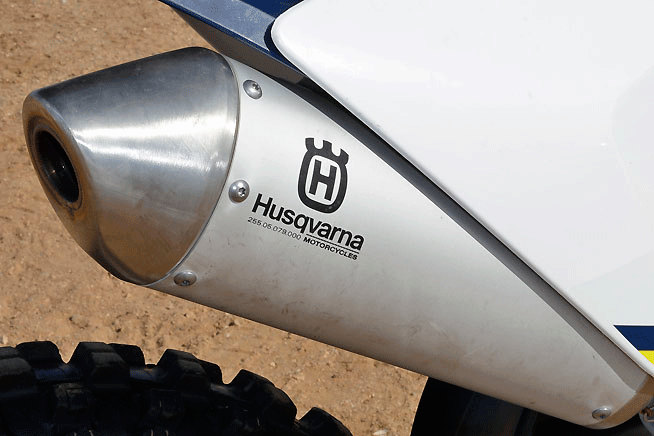
—The FC450 looks sharper than ever, thanks to completely redesigned bodywork that boasts distinctive pearl blue and electric yellow graphics against Husky’s signature white plastic.
—The FC450 gets a new Pro Taper handlebar and oversized bar pad, a new throttle assembly that offers easy adjustment of the throttle progression, and new ODI lock-on grips.
Quality DID black-anodized rims are matched to CNC-machined hubs and new lightweight spokes with silver anodized aluminum nipples. The FC450 also comes standard with Dunlop’s excellent MX52 Motocross tires.
At $9399, the Husqvarna FC450 is the most expensive 450cc motocrosser in its class, although by just a C-note more than the KTM. For that, you get a light, powerful and versatile 450cc MXer that is in serious need of fork mods to reach its true potential. It’s a high price to pay for a machine that we feel would need a little work to contend for top-of-the-class honors, but we doubt it will be enough to turn most hard-core Husqvarna fans away from motocross racing’s comeback kid.
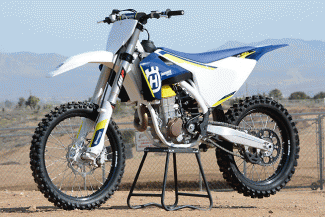 2016 Husqvarna FC450 Specifications
2016 Husqvarna FC450 Specifications
MSRP: $9399
Engine: Type 449.9cc liquid-cooled SOHC 4-stroke
Bore x Stroke: 95.0mm x 63.4mm
Compression Ratio: 12.6:1
Fuel Delivery: Keihin EMS w/Keihin 44mm throttle body
Ignition: Keihin EMS w/adjustable mapping, launch control
Transmission: 5-speed; Magura hydraulic-activated DDS clutch
Final Drive: chain
Chassis: 25CRMo4 steel central-tube frame w/carbon-fiber subframe, aluminum swingarm
Front Suspension: 48mm WP 4CS closed cartridge fork; fully adjustable, 11.8-in. of wheel travel
Rear Suspension: WP single shock; fully adjustable; 11.8-in. of wheel travel
Front Brake: Brembo two-piston caliper, GSK 260mm rotor
Rear Brake: Brembo single-piston caliper, GSK 200mm rotor
Front Tire: Dunlop MX52 80/100-21
Rear Tire: Dunlop MX52 120/90-19
Seat Height: 37.8 in.
Wheelbase: 58.4 in.
Rake: 26.9 degrees
Trail: n/a
Ground Clearance: 14.5 in.
Fuel Capacity: 1.8 gal.
Weight (claimed, no fuel): 225.2 lbs.
Color: White/Blue/Yellow
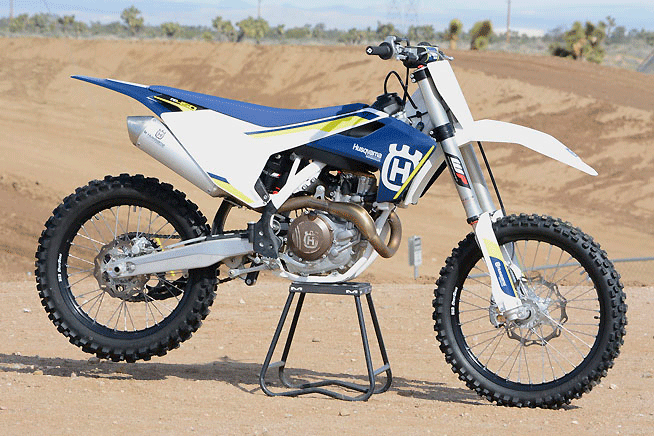
 Your Privacy Choices
Your Privacy Choices